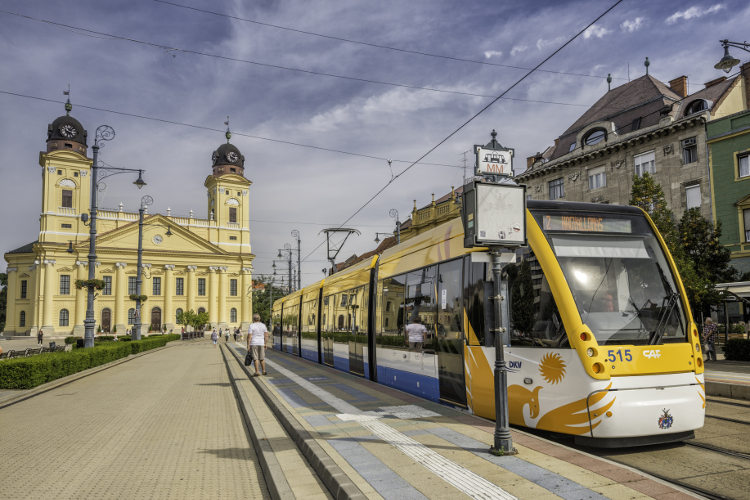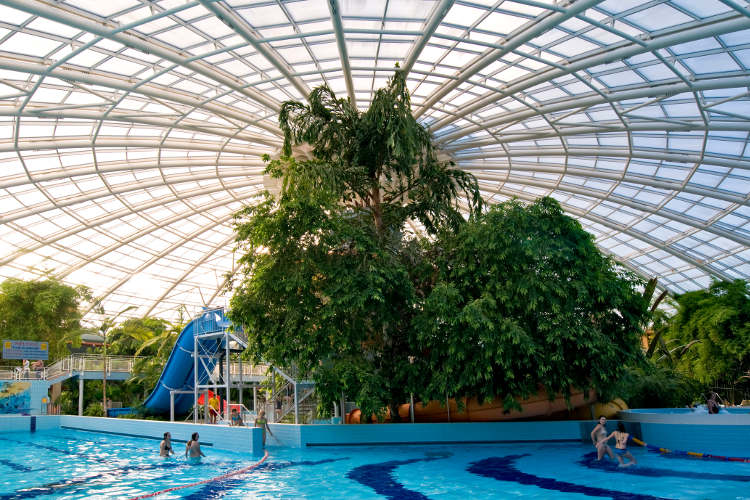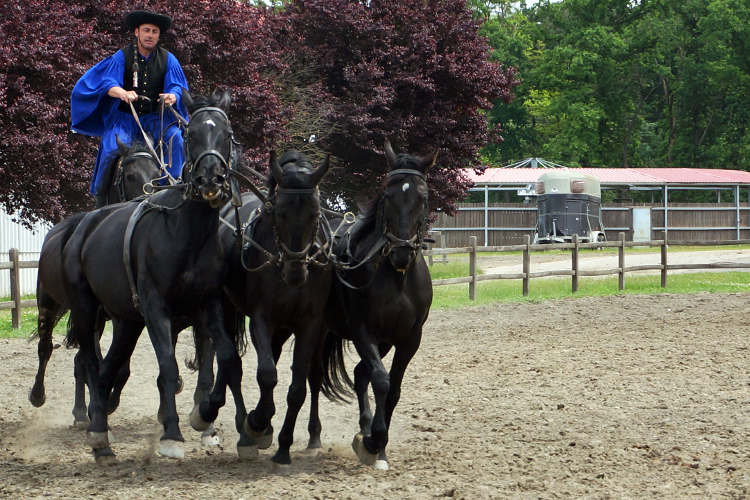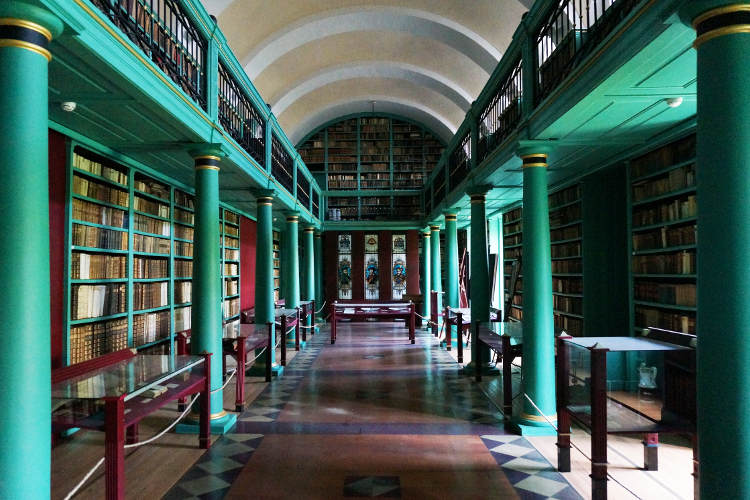
In the heart of Debrecen on Kossuth tér, a phoenix glints from a Venetian glass mosaic on the pavement. This mythic firebird is part of the city’s coat of arms, gracing Debrecen’s Millennium fountain and its trams. It’s an apt symbol for a city that rose from the ashes – quite literally – after fires throughout the Middle Ages and beyond, and devastating WWII bombings.
Thirst for renewal still dominates. In 21st-century Debrecen, museums are being eagerly revamped while former icons, such as the 1912 Water Tower, enjoy grand makeovers. It’s fitting, then, that personal rejuvenation is key to life in Debrecen. This being Hungary, rejuvenation means hot springs, natural retreats and home-cooked food.
Begin exploring Debrecen at its sense-awakening markets, such as the Flower Market (Csapó utsa). From April to October, whenever the weather’s fine, vendors busily ribbon together geraniums, lilies and flame-coloured roses. It’s a small taste of Debrecen’s best-known event, the Flower Carnival ; each year in mid-August the festival brightens the city with millions of blooms woven into towering floral compositions.
Next, reward your tastebuds at the Food Market (Vár utca). Its stalls fill daily with Debrecen’s best produce, from marbled mangalitsa pork to gleaming peppers, stuffed with cabbage, ground meat and spices. Start early for the best stuff: stallholders arrive at 6am and start to leave around 2pm.
Follow slow food with an equally leisurely pace in Nagyerdő, the ‘Great Forest’ of Debrecen’s city park. Hike tree-lined trails, snooze in the Botanic Garden or stimulate your synapses at the new AGÓRA Science Centre , also a great ruse to tire out the kids.
Since the discovery of a hot spring at the edge of the Great Forest in the late 1820s, spa culture has been ingrained in Debrecen life. Why reach for painkillers when you can idle in saunas or pummel tight shoulders under water jets? Thermally heated waters flow into Debrecen at 65℃, dropping to a toasty 34℃ to 38℃ by the time they feed the pools at opulent Aquaticum Debrecen. The waters here are a dark caramel colour, tinted by iodine, and locals boast about the healing properties of its mineral composition. So soak, steam and daydream in Aquaticum’s silky waters: remember, it’s for your health.
Gourmet stop: Just near the spa find Régi Vigadó , where catfish stew and sweet roasted duck slip down easily with a selection of Hungarian pálinka (fruit brandy).

In Hortobágy’s great plains, myths and nature reveal themselves in a whisper. At first glance this 810-sq-km expanse of puszta (plains) seems uniform: an endless grassland sliced by the wind. But listen for the trill of birdsong and distant hoof fall. Not only is the puszta a-flutter with birds from great bustards to red-footed falcons (plus an autumn migration of up to 100,000 cranes), it’s also the spiritual heart of the region, awash with folk stories and nostalgia for the golden age of Hungary’s legendary horsemen.
Central Europe’s ‘cowboys’ are little known to non-Hungarians, but here the romance of these solitary figures, thundering across the puszta, endures in popular consciousness and literature. To dramatist Mór Jókai, Hortobágy was an ‘island of the land’, afloat in the civilised world. To revolutionary author Sándor Petőfi it was ‘the forehead of God’. The horsemen represent a fading pastoral life, galloping far from city woes, leaving industrialisation behind in a dust cloud. There are more wanton folk stories too: the 167m-long Nine-Hole Bridge is linked to a fairytale in which a fleeing outlaw was rescued by his (remarkably cooperative) nine lovers, who formed a human bridge.
After the communists’ nationalisation of the puszta in 1948, horsemen lost their centuries-old occupations. But while they no longer rally flocks across the plains, their masterful horsemanship continues to be taught down the generations. You can see equestrian displays including the ‘puszta five’, where a horseman stands with a foot each on two rear animals, with three other steeds racing at the front. Hortobágy’s distinctive livestock remains too: lumbering long-horned grey cattle and woolly mangalitsa pigs are farmed as delicacies. Free-roaming Przewalski’s horses also canter this protected space, along with 300 buffalo.
To experience the puszta, horse-drawn carriage rides suit families and day-trippers; to get even closer, board a safari bus . Hot-air balloons and small planes allow a bird’s-eye view of the landscape .
Gourmet stop: At Hortobágyi Csárda (near Nine-Hole Bridge), hearty portions of gulyás (thick beef soup) and slambuc (pasta, potatoes and pork fat) are dished up on a flower-filled terrace, often to the plaintive sounds of traditional music.

Pluck the stems of grass from your puszta-whipped hair. Drift back to modern civilisation with a shock of caffeine, brewed with love at Cut & Coffee , before a cultural tour of Debrecen.
Lemon-hued Nagytemplom (Great Church) is Debrecen’s most recognisable sight and one of Hungary’s largest Protestant churches. Its distinctive twin belltower dominates the skyline; within the elegant white-walled interior is a 200-year-old organ. More stately architecture can be found at the neoclassical Calvinist College, housing a museum that unlocks Debrecen’s rich intellectual history. Particularly impressive is the library, with aqua-coloured pillars and shelves groaning with centuries-old tomes.
The city’s greatest artistic treasure is Mihály Munkácsy’s trilogy of paintings depicting Christ’s Passion, now returned to pride of place at the Déri Museum, in a specially created exhibition room. Such was the artist’s dedication that he even had himself affixed to a cross to better convey Christ’s physical suffering. The work is a neck-craning spectacle, the largest canvas measuring 4.6m by 7.12m. Change the pace by checking out slick Modem – the halls of this contemporary art gallery, flooded with natural light, host rotating exhibitions.
Finally, toast the end of your culture crawl with your best Hungarian pronunciation (‘cheers’ is egészségedre). Di Vino has a dizzying range of Hungarian wines, while spirits flow freely in raucous ruin bar Roncsbár . Either way, your head will soon be spinning with dreams of a return visit.
Gourmet stop: Ikon restaurant’s inventive twists on classic Hungarian dishes pepper a menu rich in locally sourced produce. Juicy double sausage – a Debrecen specialty – is a must, with melt-in-the-mouth mangalitsa pork.

Wizz Air has daily flights from London and twice-weekly flights from Eindhoven. In December 2015 the budget airline will launch new routes between Debrecen and Brussels, Malmo and Paris. If you’re expanding an existing trip to Budapest, trains serve Debrecen (2½ hours) every two hours. Vienna is also linked by daily trains.
Debrecen is walkable and a stay at atmospheric boutique hotel Régi Posta situates you moments from the city museums, trams and nightlife of Hal Köz.